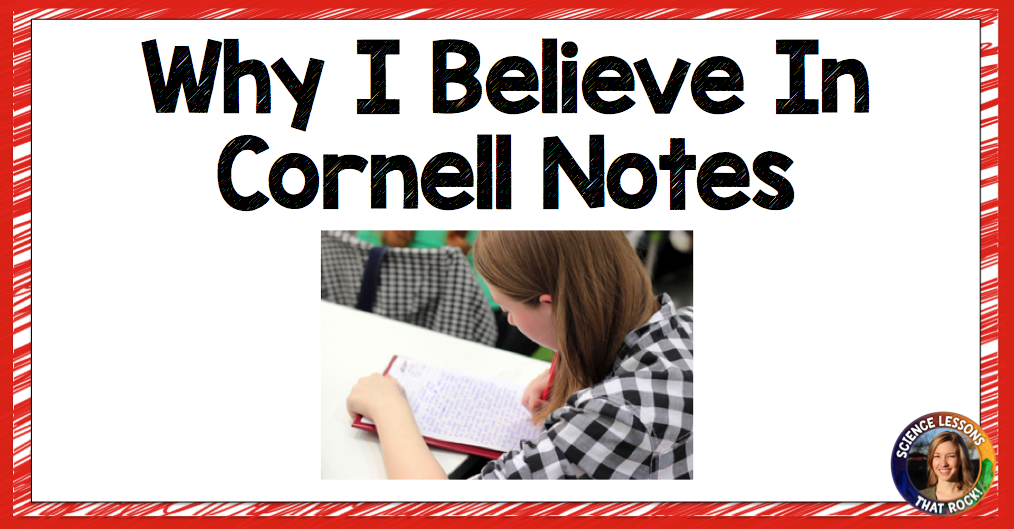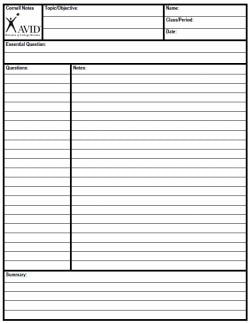You can also repin this blog post for later by clicking here.
My first year teaching was at an AVID demonstration school. If you are familiar with the AVID program, they require students to use Cornell notes during class. I was fresh out of college and had never heard of them before. I was really excited to use interactive notebooks and to be honest I wasn’t thrilled with having a set note-taking format I had to use. It felt like I spent the first month of school telling students what to write on the left side of their notes, and what to write on the right side. Getting them to write summaries was like pulling teeth. BUT, after a couple of months things got easier, and students got better at knowing what to write. Eventually students enjoyed having structure instead of messy note pages. I tried my best to make sure my powerpoint slides had clear questions and bolded vocabulary so students knew exactly what to write and what was important. I initially tried to get students to write the summary for homework, but I soon realized they just weren’t going to do it. Enter plan B. Instead I would go back the next day and have them review their notes and write the summary for bellwork. It was a great way to refresh their memories on what they learned the previous day. Then I would call on 2 or 3 students to read their summaries out loud, which increased the stakes for writing in complete sentences and explaining things in their own words, not just regurgitating vocabulary words and definitions. Often times students would even call each other out, and say things like “You forgot to answer the essential question!” By the end of the school year my little 6th graders were champs at taking notes.
Fast forward 10 years and I now teach a class of seniors who are taking college biology through duel enrollment. One of the entrance requirements to this duel enrollment course is for students to have been in AVID all 4 years of high school. It has been amazing to see them take notes without asking, and not just during standard lectures. We have had multiple guest speakers visit our classroom, and students automatically set up a notes page, write down notes and questions they have throughout the presentation, and summarize what the speaker taught them. All without groaning. THAT, my teacher friends, is amazing to see.
So in summary, here are a few things to take away…
Why Cornell notes are good for students:
- Cornell notes give students structure. Organization is key to success!
- Cornell notes allow for student summary and reflection. These are also great ways to formatively assess what they learned and identify misconceptions from the lesson.
- I’ve heard arguments that when students get to college, they won’t take written notes anymore, and will just use their laptops. I have 2 counter arguments: First, typing is not a skill that most schools teach anymore (unfortunately). My students are excellent at texting, but horrible at typing. I’ve even seen kids type essays on their cell phone, because it is faster for them than typing on a standard keyboard. So when these students get to college, they might find hand writing notes to be more efficient than typing. Second, I feel that written notes are much better for visual learners than typed notes. When I write notes by hand and add diagrams, during tests I can visually see where the answer to the question is on my notes page. Typed notes aren’t nearly as effective in that manner.
Tips on how to make them easier to use:
- Have a ton of copies of Cornell notes pages ready to go. It will save a bunch of time when students don’t have to set up their own. You wouldn’t think drawing a few lines would take much time, but your OCD kids will whip out their rulers and take 5 minutes.
- During lectures, give students questions at the top of your slides. Don’t make them guess what they are learning about.
- Highlight or bold important vocabulary or points for them. We all know that if students wrote down every.single.word on the slide, notes would take 3 hours. Emphasize to them what is important.
- Give students opportunities to refer back to their notes throughout the unit. Notes should not just be one time use. (You can check out my blog post on why I let my students use notes on tests HERE). Make your students refer back to their notes for bellwork. Ask them to write their summaries. Have them go back and highlight vocabulary or add diagrams. Have them add questions about things they still don’t understand. Ask them to link new concepts to prior learning that took place (this is huge in science!)
If you haven’t tried Cornell notes before, I would urge you to try them for one school year. Don’t just try it for a few weeks and give up, because it is a process that takes time. I know that once students get the hang of them, their ability to receive and retain new information will increase. I’ve seen it happen!









